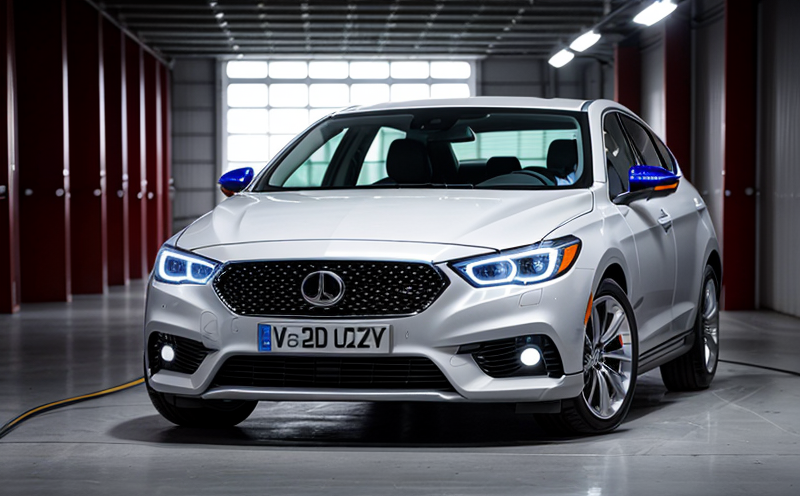ECE R112 Photometric Testing of Automotive Headlamps
The ECE R112 regulation is a crucial standard that governs the photometric performance and conformity assessment of automotive headlamps. This testing ensures that headlights meet stringent international safety standards, enhancing road safety by guaranteeing consistent beam distribution, glare control, and visibility under various driving conditions.
Photometric testing is performed in accordance with ISO 13754-2:2008, which provides detailed procedures for the measurement of headlamp performance. The test setup typically includes a photometer capable of measuring luminous intensity at specified angles, as well as a goniophotometer to capture the full angular distribution of light emitted by the headlamps.
The testing process involves several critical steps:
- Installation and alignment of the headlamp in the test fixture
- Calibration of the photometric measurement equipment
- Measurement of luminous intensity at various angles
- Calculation of beam spread, glare level, and compliance with specified limits
The results of the ECE R112 testing are essential for manufacturers to ensure their products meet regulatory requirements. Non-compliance can lead to product recalls, fines, and reputational damage. Compliance also opens up access to markets in countries that recognize this regulation.
Our laboratory uses state-of-the-art equipment and experienced personnel to conduct these tests efficiently and accurately. Our team stays updated with the latest standards and regulatory changes to ensure our clients remain compliant with international requirements.
| Test Parameter | Description |
|---|---|
| Luminous Intensity | The measured light output at specific angles, crucial for ensuring proper beam distribution and glare control. |
| Beam Spread | The angular extent of the headlamp’s illuminated area on a screen placed at a specified distance from the vehicle. |
| Glare Level | An indicator of the potential for discomfort or distraction to other road users, measured in terms of light distribution and intensity. |
The ECE R112 testing process is not just a regulatory requirement but also serves as a critical tool for innovation. By adhering to these standards, manufacturers can ensure their headlamps perform optimally under various driving conditions, which is essential in today’s diverse and challenging road environments.
Why It Matters
The importance of ECE R112 testing cannot be overstated. Headlights are one of the most critical safety features on a vehicle, directly influencing visibility and driver reaction time in low-light conditions. Ensuring compliance with these standards is vital for several reasons:
- Enhanced Road Safety: Properly tested headlamps significantly reduce the risk of accidents caused by poor visibility or glare.
- Market Access: Compliance opens up access to numerous markets, including Europe and other regions that recognize this regulation.
- Brand Reputation: A reputation for quality and safety is crucial in the automotive industry. Compliance with international standards enhances brand image and customer trust.
- Regulatory Compliance: Non-compliance can result in significant financial penalties, product recalls, and reputational damage.
The testing process not only ensures that headlamps meet safety requirements but also supports the development of innovative lighting technologies. By adhering to these standards, manufacturers can ensure their products perform optimally under various driving conditions, contributing to safer roads for everyone.
International Acceptance and Recognition
The ECE R112 regulation is widely recognized and accepted in many countries around the world. It is part of the EU’s New Regulatory Technical Standards (REACH) and is applicable to all new vehicles sold within the European Union.
Beyond Europe, several other regions have adopted or are considering adopting this standard. Countries such as Australia, New Zealand, and parts of Africa also recognize the importance of ECE R112 compliance for imported vehicles. This global acceptance highlights the significance of ensuring that headlamps meet these stringent standards to maintain market access and safety.
Our laboratory is equipped with the necessary expertise and facilities to conduct these tests, ensuring that our clients can comply with international regulations without delay. We stay updated on regulatory changes to provide comprehensive support for our clients’ global operations.
Use Cases and Application Examples
ECE R112 testing is applicable in various scenarios, from the initial design phase of new headlamp models to periodic quality checks during production. Here are some specific use cases:
- New Product Launch: Ensuring that a newly designed headlamp meets all regulatory requirements before it can be marketed.
- Quality Control: Periodic testing during manufacturing to ensure consistent performance and compliance with standards.
- Compliance Audits: Meeting the demands of regulatory bodies or third-party auditors to verify compliance.
- Product Modifications: Testing modifications made to existing headlamp models to ensure they still meet all requirements after changes have been implemented.
| Use Case | Description |
|---|---|
| New Product Launch | Initial testing of a new design to ensure compliance with ECE R112 standards before market release. |
| Quality Control | Regular checks during manufacturing to maintain consistent product quality and compliance. |
| Compliance Audits | Testing conducted in response to regulatory or third-party auditor requests for verification of compliance. |
| Product Modifications | Testing after changes are made to an existing design to ensure continued compliance with the standard. |
In addition to these specific use cases, ECE R112 testing is also crucial for manufacturers participating in international automotive markets. Ensuring that headlamps meet this standard can open doors to new markets and enhance brand reputation.





